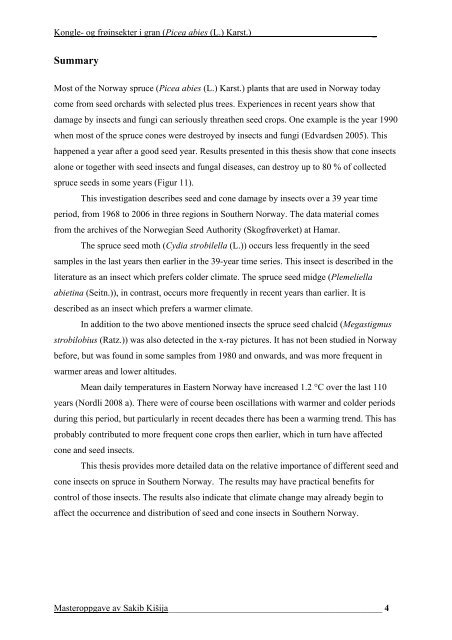Kongle- og frøinsekter i gran Sakib Kišija - Skogfrøverket
Kongle- og frøinsekter i gran Sakib Kišija - Skogfrøverket
Kongle- og frøinsekter i gran Sakib Kišija - Skogfrøverket
Create successful ePaper yourself
Turn your PDF publications into a flip-book with our unique Google optimized e-Paper software.
<strong>Kongle</strong>- <strong>og</strong> <strong>frøinsekter</strong> i <strong>gran</strong> (Picea abies (L.) Karst.) _<br />
Summary<br />
Most of the Norway spruce (Picea abies (L.) Karst.) plants that are used in Norway today<br />
come from seed orchards with selected plus trees. Experiences in recent years show that<br />
damage by insects and fungi can seriously threathen seed crops. One example is the year 1990<br />
when most of the spruce cones were destroyed by insects and fungi (Edvardsen 2005). This<br />
happened a year after a good seed year. Results presented in this thesis show that cone insects<br />
alone or t<strong>og</strong>ether with seed insects and fungal diseases, can destroy up to 80 % of collected<br />
spruce seeds in some years (Figur 11).<br />
This investigation describes seed and cone damage by insects over a 39 year time<br />
period, from 1968 to 2006 in three regions in Southern Norway. The data material comes<br />
from the archives of the Norwegian Seed Authority (Sk<strong>og</strong>frøverket) at Hamar.<br />
The spruce seed moth (Cydia strobilella (L.)) occurs less frequently in the seed<br />
samples in the last years then earlier in the 39-year time series. This insect is described in the<br />
literature as an insect which prefers colder climate. The spruce seed midge (Plemeliella<br />
abietina (Seitn.)), in contrast, occurs more frequently in recent years than earlier. It is<br />
described as an insect which prefers a warmer climate.<br />
In addition to the two above mentioned insects the spruce seed chalcid (Megastigmus<br />
strobilobius (Ratz.)) was also detected in the x-ray pictures. It has not been studied in Norway<br />
before, but was found in some samples from 1980 and onwards, and was more frequent in<br />
warmer areas and lower altitudes.<br />
Mean daily temperatures in Eastern Norway have increased 1.2 °C over the last 110<br />
years (Nordli 2008 a). There were of course been oscillations with warmer and colder periods<br />
during this period, but particularly in recent decades there has been a warming trend. This has<br />
probably contributed to more frequent cone crops then earlier, which in turn have affected<br />
cone and seed insects.<br />
This thesis provides more detailed data on the relative importance of different seed and<br />
cone insects on spruce in Southern Norway. The results may have practical benefits for<br />
control of those insects. The results also indicate that climate change may already begin to<br />
affect the occurrence and distribution of seed and cone insects in Southern Norway.<br />
Masteroppgave av <strong>Sakib</strong> <strong>Kišija</strong>_______________________________________________ 4


